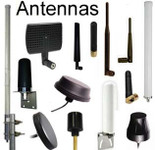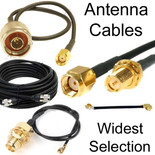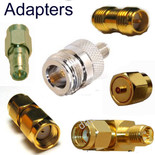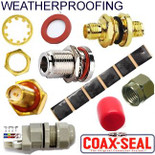Wireless Bridges for Long Range Links: Point to point & multipoint
WiFi Bridges applications
Long-distance point to point links: Ubiquiti offers several types of bridges that are excellent options:
- The PowerBeam series is the best equipment for low-cost point-to-point links, of up to 6 miles (depending on congestion), if high throughput is not needed: One PowerBeam on each end of the link.
- For very long-distance links (over 7 miles): Use a Ubiquiti RocketM5 with a RocketDish on each side of the link:
- Use the 30dBi RocketDish (2-FT diameter) for less than 20 miles.
- For more than 20 miles, use the RocketDish 34dBi, which is 3-FT in diameter.
Point-to-point bridges: Antenna-type used in a is parabolic-type antenna:
- Parabolics are also known as "dish" or "grid" antennas. Grid or dish antennas are far better than Yagi for point to point.
- Ubiquiti bridges have a parabolic antenna integrated as part of the bridge
Point-to-multipoint bridges: Antenna-type used is typically sectoral or panel antenna, but Yagi antennas can be used.
- For long point-to-point to multipoint links to end-users (such as a marina): RocketM2 with a large 2.4GHz sectoral antenna
- For long point-to-multi-point links to locations such as a building: Use Ubiquiti RocketM5 with a large 5GHz sectoral antenna
- Point-to-multipoint bridge using Ubiquiti NanoSation M5 (5GHz) passing signal through 3 or 4 walls in an apartment building with NanoStation M5 on each end
- WiFi Frequency Ranges: 2.4GHz, 5GHz, 900MHz: (uses, advantages & disadvantages of each frequency band)
- Mounts for Bridges
If you are not an expert, and you are experimenting with trying to make a very long-distance link try this:
- Use a signal booster with a high-gain antenna on one end. Test and if it's not enough signal-strength; put a high-gain antenna on both ends.
- If it's not enough signal-strength: Put a high-gain grid antenna (such as the A24 Grid Antenna above-left) on both ends.
- 4Gbps throughput achieved by 4x4 MIMO, Dual Link, Beamforming & "Auto Everything" technologies:
- Range up to 100-km. Throughput over long distances of approximately 1Gbps, even with congestion in 5 GHz band
- We can project throughput for your point-to-point link requirement
Ubiquiti airMAX: TDMA using pre-designated time slots
airMAX™ is Ubiquiti's primary platform / protocol, and is mostly on their outdoor access points and bridges AirMax 802.11n products:
AirMax MIMO 2x2 technology & dual-polarity antenna technology enable much faster data-throughput & higher bandwidth: Therefore these technologies enable high concentrations of VOIP, streaming media, IP cameras, IPTV.
 AirMax products have a capital M in the sku or the name (example
NanoStationM2 sku NSM2). For Data Alliance has almost all Ubiquiti items in
stock maximum data-throughput & highest bandwidth: Use AirMax products that
are
MIMO / 2x2, and if an external antenna is required, combine with a
dual-polarity antenna.
AirMax products have a capital M in the sku or the name (example
NanoStationM2 sku NSM2). For Data Alliance has almost all Ubiquiti items in
stock maximum data-throughput & highest bandwidth: Use AirMax products that
are
MIMO / 2x2, and if an external antenna is required, combine with a
dual-polarity antenna.
Unlike standard WiFi protocol, Ubiquiti’s Time Division Multiple Access (TDMA) airMAX protocol allows each client to send and receive data using pre-designated time slots scheduled by an intelligent AP controller. This “time slot” method eliminates hidden node collisions and maximizes airtime efficiency. It significantly improves performance in throughput, reduces latency, and increases scalability compared to all other outdoor systems in its class.
- Intelligent QoS Priority is given to voice or video for seamless streaming.
- Scalability High capacity and scalability.
- Long Distance Capable of high-speed links up to 100+ km.
- Latency Multiple features dramatically reduce noise.
Ubiquiti Rockets: Use Dual-Polarity 2x2 Antennas (or the MIMO does not work)
If you use an antenna that is not 2x2 MIMO (if it only has one connector) you will not get 2x2 MIMO from the Rocket:
If the antenna only has one connector, you will only get one spatial stream rather than two (1x1 rather than 2x2) hence the throughout will be half of the throughput you would get with 2x2 MIMO.
The best antennas for the Ubiquiti Rockets are the 2x2 dual-polarity antennas from Ubiquiti - because:
- the two connectors for 2x2 MIMO and
- the rocket snaps right in to the back of the UBNT antennas.
Ubiquiti legacy products: Great low-cost alternative to AirMAX by upgrading firmware
First-generation Ubiquiti products such as NanoStation2 and NS5, Loco2 & Loco5, Bullet2, Bullet2HP are a great alternative to AirMAX CPE at a significantly lower price.
By upgrading your legacy Ubiquiti products to V.4 firmware, you will have compatibility and benefits of AirMAX protocol. Be sure to have your APs using AirMAX firmware V.5.5 or a newer version.
Ubiquiti POE switches: management of
Ubiquiti switches set up in the same IP subnet will appear in the AirControl management software and you can manage them there: Set ports as POE or Ethernet or both.Effect of a double-slant (45 degree) antenna offset, on Mimosa B5c
In the presence of rain, vertically polarized waves attenuate less than horizontal polarized waves. Rotating the vertical polarization to be more horizontal would normalize the performance between the two polarizations during rain, but it would also result in lower overall performance because of the additional rain fade.
Mimosa has implemented a software Transmit Power Control (TPC) algorithm that attempts to equalize Rx signal strength across the 4 chains if they are unequal.
For these reasons, Mimosa normally recommends maintaining standard antenna orientation (horizontal polarization parallel with ground, vertical polarization perpendicular to ground) when using the B5/B5c. This especially applies to longer backhaul links in areas that experience heavy precipitation.
Mimosa B5c link examples
Seven-Mile Link in Arizona: Actual throughput (MAC layer): 300-400Mbps: From small town to tower in remote area: April 2015- Using B5c with 34dBi dishes on both sides
- A lot of interference from operator's own APs on one towers (12 APs on remote tower, 4 on the small-town tower).
- Using 20-40MHz DFS channels
- Not using RFArmor
- This is an actual, working link
- Noise floor: 90.49dBm
- 21km link from a building in the city, out to a suburban or rural location, with one hill or small mountain in the path, but this is not high enough to be in the frenzel zone.
- To make this 21km link, customer will need B5c with 34dBi dual polarity dish (2FT) on each end. B5 with its 25dBi antenna gain is not sufficient.
- Throughput at MAC layer: 200Mbps. For higher throughput, you would need RFArmor.
Optimizing Mimosa backhaul link: B5 and B5c
Optimization of the link involves trying different settings of channel sizes and power:- Long links: For links over 10 miles / 22km: Smaller channel size 20MHz is almost certainly going to work best on a link of this distance. You should try 20MHz and then compare to 40MHz to compare the throughput with each size.
- Short links can use a wider channel size: 40 to 80 MHz, to get more throughput (as long as there is not too much interference). Experiment with the channel size and see which one gives you the most throughput.
- Power level: Adjust the power to see if you get more throughput by adjusting up and down
Posted by George Hardesty on 20th Aug 2022

























